Most official highway signs are clearly governmental, laying out speed limits, providing traffic instructions or giving directions and distances. Those huge blue interstate exit signs, though, familiar and useful as they may be, break that mold by featuring mainly commercial enterprises. So what does it take for a private for-profit business to get a coveted spot on one of these signs? And, in turn: what can these signs tell drivers about their options at a given exit?
Detailed answers vary from state to state, but there is some overall consistency to the setup. Across the nation, specific service signs (aka interstate logo signs) help “weary travelers searching for gas, food, or lodging close to the highway,” explains David Tracy of Jalopnik. And “the signs aren’t solely there to help out motorists, as they also provide monetary benefit to businesses and, crucially, to the state.”
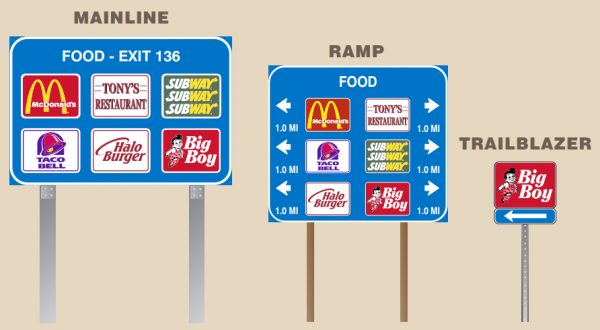
There are three primary types: mainline, ramp and trailblazer. These are mostly found on interstates but also some state and U.S. highways.
- Mainline signs are largest and situated alongside the highway, with an overhead exit number helping drivers decide where to get off
- Ramp signs tell drivers which way to turn after they exit, directing them to turn left or right at the top of the ramp
- Trailblazer signs can give more detailed directions along the route, guiding drivers to businesses located further from an exit
[Note: some states (including California) further classify specific services signs into two categories: specific information signs (e.g. mainlines) and supplemental directional signs.]
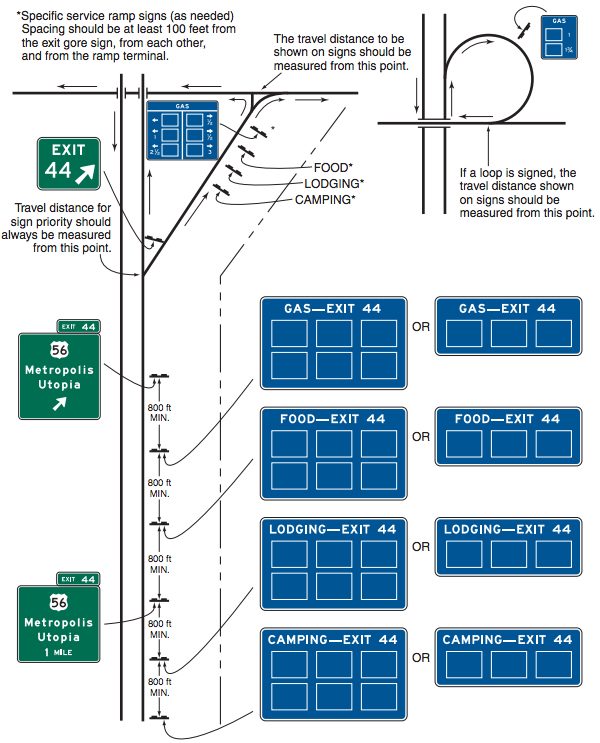
Generally, businesses that fit into core categories — gas, food, lodging, camping, pharmacy and attraction — are eligible, but there are a lot of caveats related to business types and locations.
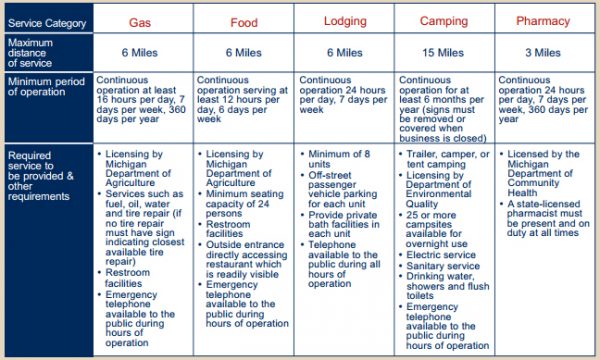
Depending on the state, a qualifying business may have to be open a certain number of hours per day and days per year. There are distance restrictions, too, limiting how far a business can be from the highway (anywhere from one to a few miles). In some places, restaurants have to meet minimum seating and parking requirements while gas stations must provide certain basics (e.g. water, oil, telephones and restrooms).
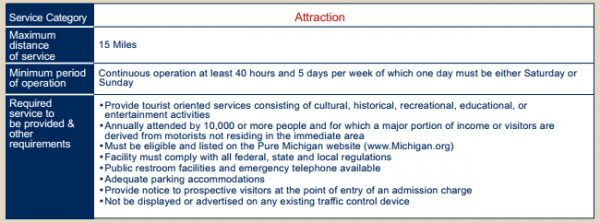
Even then, placement isn’t necessarily guaranteed. Some states have waiting lists while others prioritize businesses closer to the highway. A given business may have to stand in line for years to get a spot.
Spots on signs cost money, too. Depending on the location, businesses may pay hundreds to thousands of dollars a year for a sign in one direction (both directions adds to the price). Special logos are often needed to fit the dimensions of the signs, too (easy for corporate franchises, but an added cost for independent businesses).
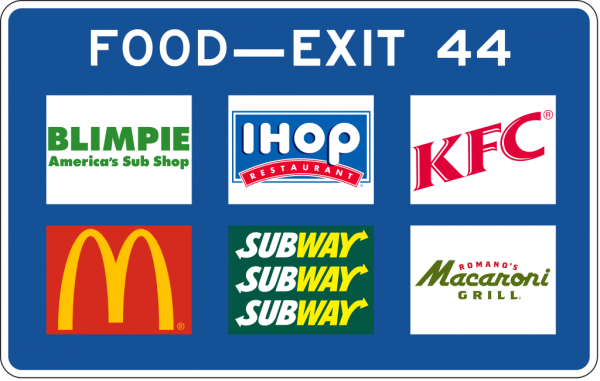
Fees, like inclusion criteria, vary state by state. In some cases, they are based on visibility, set higher along major traffic routes. Overall, mainlines are the most expensive followed by ramp signs. Smaller trailblazer signs are relatively cheaper, but can add to the bill as well.
Indirectly, states benefit from taxing business revenue, though direct fee earnings can be put to good uses, too. In California, extra revenue generated from a slight (roughly 25%) markup (over the cost of putting up and maintaining signs) gets put toward safe rest areas for drivers. Some states, like Oregon, also offer discounts to non-profits.

All in all, it can cost a business up to a few thousand dollars per year to be featured on these various types of signs close to a given exit. But as anyone who has followed them to find food, fuel or a place to sleep can attest: they can pay off, too.
In turn, knowledge of state-specific sign regulations can help drivers trying to determine whether to take an exit. The rules can be tricky to remember, but travelers in the know can deduce whether businesses at a given exit are likely to be open and what they will have to offer.



Comments (5)
Share
The biggest improvement would be to add distances on the Mainline signs. We have all gotten off, only to see “3.0 miles” for the gas station. That’s an extra 10 minutes or so.
This is why I love 99pi. I have always wondered about the process behind this.
Beautiful Nerds.
Same! I heard Roman asking at the end of an episode if I’d ever wondered about what it takes to get on one of these blue signs and I gasped, “I have!”
Our GPS tells us about the retailers in the vicinity. I suspect in-car advertising will take over from the roadside type in the next decade or so.
I had no idea that specific service signs and their shapes determined how far people would need to go to get there. You said that mainline exit signs are meant to show the stops right on the road. Next time I go on a road trip, I’m going to pull up this article so I know what to look for.